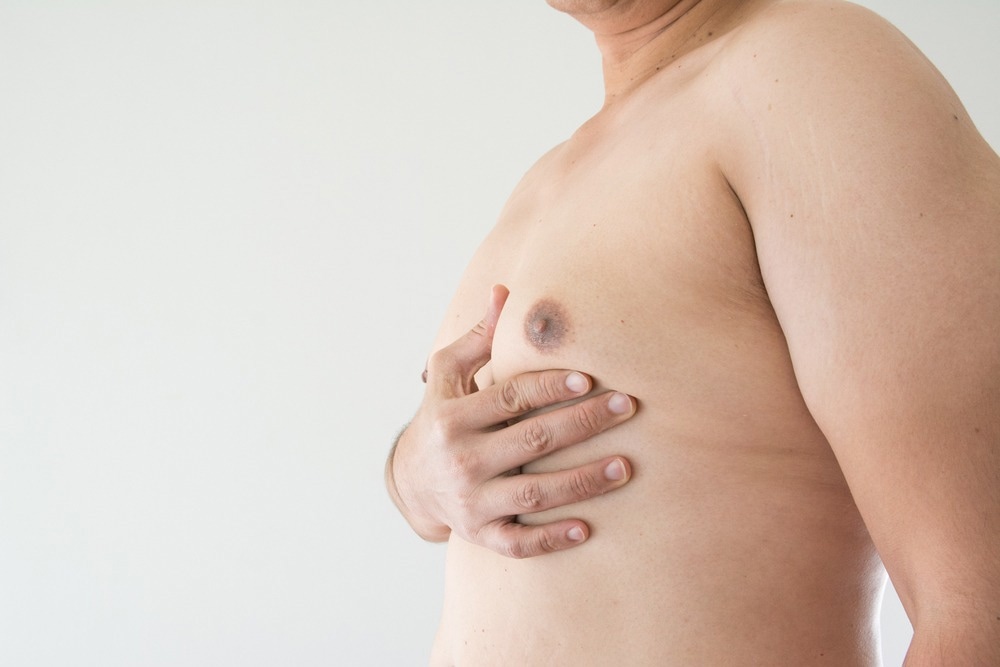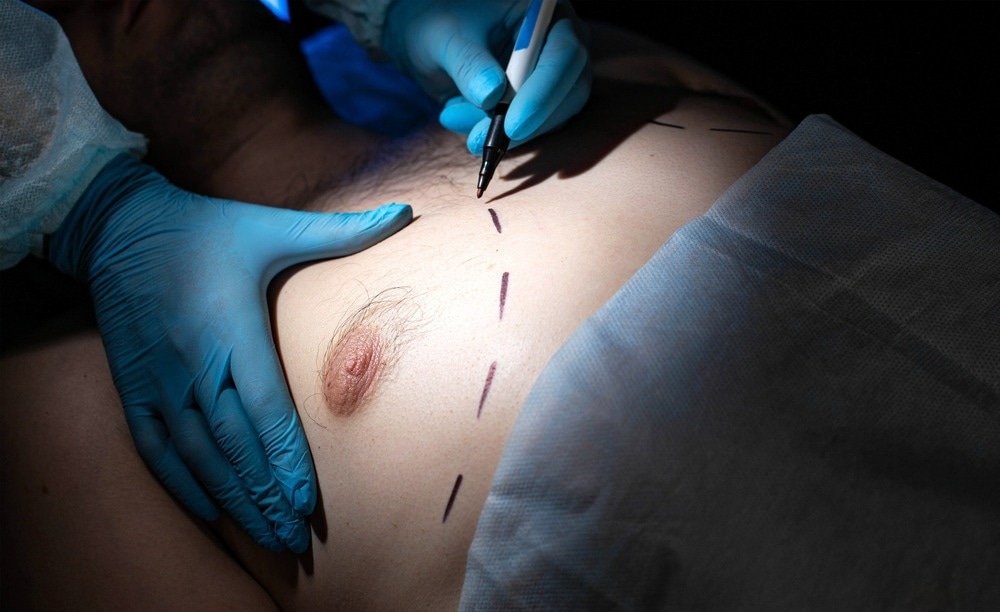What causes gynecomastia?
Etiology and epidemiology of gynecomastia
Pathophysiology of gynecomastia
Treatments for gynecomastia
References
Further reading
Gynecomastia is defined as the benign proliferation of male breast glandular tissue with a size exceeding two centimeters. When examined, it appears as a firm, palpable, subareolar gland and ductal breast tissue.

Image Credit: PRASAN MAKSAEN/Shutterstock.com
In simplistic terms, gynecomastia is an increase in the male breast volume and is traditionally associated with hormonal incidences such as birth, adolescence, and old age. This enlargement of the male breast volume is due to increased ductal tissue, stroma, or fat mass.
What causes gynecomastia?
There are several causes (etiologies) of gynecomastia, including obesity, steroid use, implementation of pharmacological agents, and underlying medical conditions such as hypogonadism and kidney and liver failure. Despite these several causes, however, most patients’ gynecomastia is idiopathic (the cause for which is unknown).
Etiology and epidemiology of gynecomastia
Gynecomastia can appear transient at birth due to increased circulating maternal estrogens. Later in life, gynecomastia may appear due to hormonal changes during puberty, resulting in an imbalance between estradiol and testosterone. Further still, gynecomastia may arise in old age (> 65 years); this hypertrophic increase in breast volume is thought to be due to a decline in testosterone levels as well as a shift in the ratio of testosterone to estrogen. Moreover, older men are likely to be on medications with side effects, including gynecomastia.
Underlying medical conditions which cause gynecomastia include breast cancer, hypogonadism, adrenal disease, obesity, thyroid disease, liver cirrhosis, renal failure, and malnutrition.
In particular, tumors that affect adrenal glands, pituitary glands, the testes, and lungs, are thought to be the most salient etiological causes of gynecomastia due to their ability to induce hormonal changes.
Medications implicated in developing gynecomastia include estrogens, theophylline, thiazides, and phenothiazines.
Pathophysiology of gynecomastia
The hormone estrogen is responsible for the augmentation of glandular tissue alongside the suppression of testosterone secretion. The luteinizing hormone Is suppressed by estrogen; this hormone mediates testosterone secretion from the testes.
Gynecomastia that occurs during puberty is thought to be caused by an elevated or accelerated rise in estradiol relative to the rise of testosterone. This subsequently causes an imbalance that normally regresses over time as testosterone levels gradually increase.
Medical conditions, including any tumors of the pituitary, adrenal gland, and testes, can alter the hormonal profile seen in males, including an increase in estrogen and a decrease in testosterone. These imbalances lead to overall hormonal imbalances, which can cause gynecomastia in some males.
Three types of gynecomastia have been identified. These include florid, fibrous, and intermediate. Florid gynecomastia is characterized by an increased volume of ductal tissue and vascularity. It is most commonly seen in the early stages of the condition.
Fibrous gynecomastia is observed following a year of suffering from the condition and is characterized by the presence of stroma fibrosis with fewer ducts. As suggested by the name, intermediate gynecomastia is intermediate between the fibrous and florid types, with both features present.
In most cases, if gynecomastia persists longer than a year, the fibrous type is more prevalent and irreversible, which may subsequently reduce the likelihood of success of medical treatment.
Treatments for gynecomastia
Gynecomastia is graded depending on the amount of breast enlargement and skin excess observed.
Medical treatment for gynecomastia aims to correct the imbalance between estrogen and androgens. There are three major pathways through which this is achieved:
Grade I is marked by small enlargement and no excess skin. Grade II presents moderate enlargement and no excess skin. Grade IIb also results in moderate enlargement, but excess skin is seen. In Grade III, there is marked enlargement with skin excess.
- Blocking the effects of estrogen on the breast
- Administering androgens
- Inhibiting the production of estrogen
The efficacy of pharmacological treatment of gynecomastia is restricted to small case series and case reports. These often do not contain control groups, resulting in difficulty in obtaining conclusions. Overall, data are inadequate to support pharmacological therapy in the context of pubertal gynecomastia. In any case, surgery may be considered if there is no reduction in breast volume observed after at least one year.

Image Credit: HENADZI KlLENT/Shutterstock.com
Surgical treatment of pubertal gynecomastia is often considered in male adolescents who are not obese and who present with persistent breast enlargement exceeding 12 months. They must also evidence intractable breast pain or tenderness or maybe suffering significant psychosocial distress. Surgical treatment aims to limit scar tissue, remove access growth, and return to a ‘normal’ chest shape.
Gynecomastia is not considered life-threatening, but it can cause significant emotional distress. Though the condition can resolve itself, this may take several months or years. Young people in particular with gynecomastia, have been shown to become depressed, isolated, and withdrawn; these young adolescents may also suffer from low self-esteem.
In addition, there is a very small risk of breast cancer. As such, gynecomastia is often managed by interdisciplinary teams that include pharmacists and nurse practitioners. Initially, the aim is to rule out any medications that may cause the disorder; therefore, a review is necessary to determine whether any problematic drugs are causing the condition. In addition, some patient education may be necessary as the use of alcohol and marijuana are common causes of gynecomastia.
Surgery is typically avoided unless a surgical emergency is necessary, and in many cases, resolution occurs spontaneously. If patients are treated with anti-hormonal drugs, there is a need to educate the patient on the adverse effects that these may incur.
References
- Vandeven HA, Pensler JM. Gynecomastia. [Updated 2021 Aug 13]. In: StatPearls [Internet]. Treasure Island (FL): StatPearls Publishing; 2022 Jan-. Available from: https://www.ncbi.nlm.nih.gov/books/NBK430812/
- Lemaine V, Cayci C, Simmons PS, Petty P. Gynecomastia in adolescent males. Semin Plast Surg. 2013;27(1):56-61. doi:10.1055/s-0033-1347166.
- Jin Y, Fan M. Treatment of gynecomastia with prednisone: case report and literature review. J Int Med Res. 2019 May;47(5):2288-2295. doi: 10.1177/0300060519840896.
- Baumann K. Gynecomastia - Conservative and Surgical Management. Breast Care (Basel). 2018;13(6):419-424. doi: 10.1159/000494276.
- Reisenbichler E, Hanley KZ. Developmental disorders and malformations of the breast. Semin Diagn Pathol. 2019;36(1):11-15. doi: 10.1053/j.semdp.2018.11.007.
- Soliman AT, De Sanctis V, Yassin M. Management of Adolescent Gynecomastia: An Update. Acta Biomed. 2017;88(2):204-213. doi: 10.23750/abm.v88i2.6665.